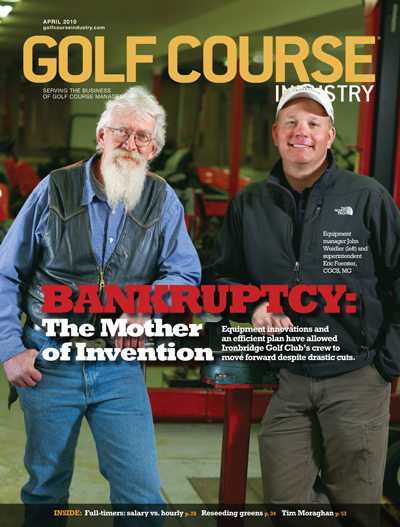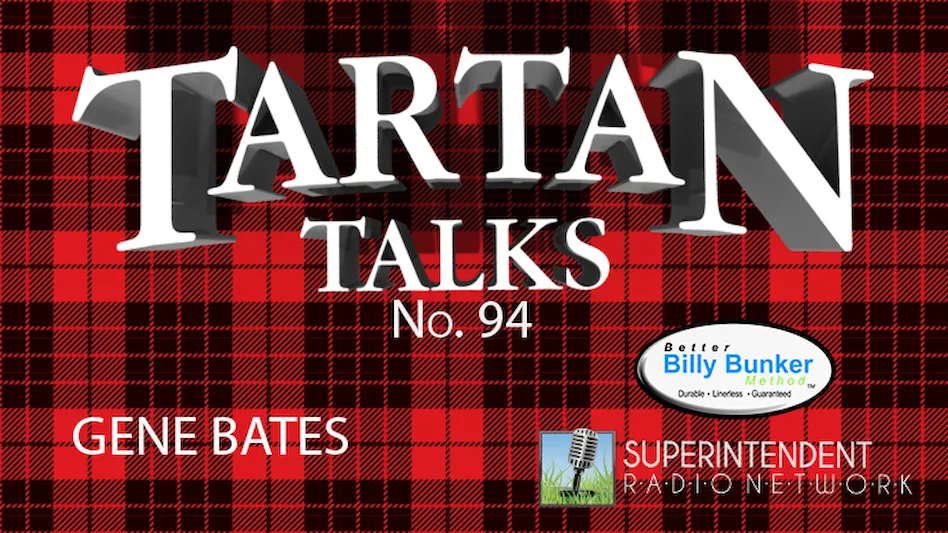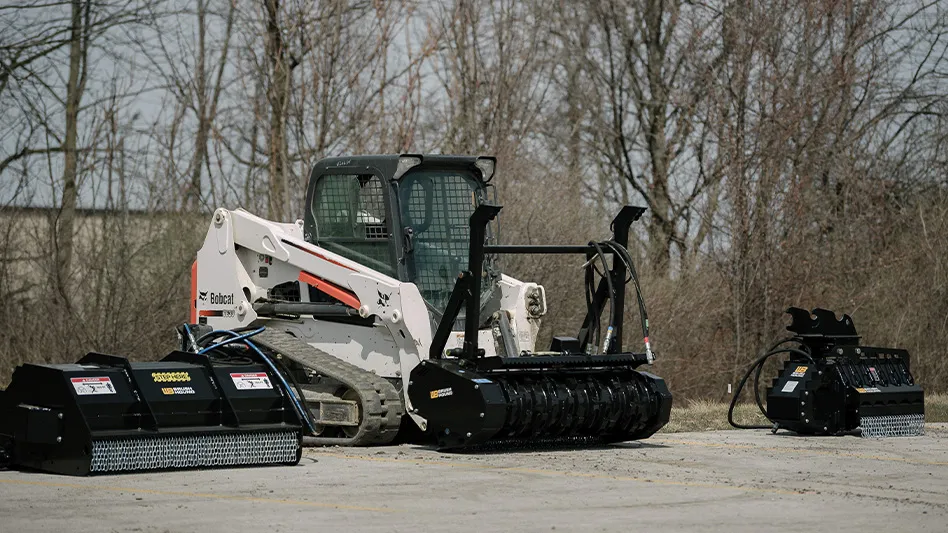The Mother of Invention
Ironbridge Golf Club isn’t easy to maintain. It’s nine miles around, has a 500-foot elevation change from the pro shop to the tee and is the wintering ground for several hundred elk.
Those variables didn’t change when resources were slashed as a result of the facility, a holding of financial services giant Lehman Brothers, declaring Chapter 11 bankruptcy last February.
Ironbridge’s maintenance staff had been operating with caution since Lehman Brothers filed for the largest bankruptcy in U.S. history on Sept. 15, 2008. But several links down the corporate chain, operations at Ironbridge in Glenwood Springs, Colo., hadn’t yet been affected.
Last February everything changed overnight, says operations manager and golf course superintendent Eric Foerster, CGCS, MG.
“I got a call from the bank saying our accounts had been frozen,” Foerster says. “Before that there was no indication they were going to put us into bankruptcy. It happened very quickly.”
The golf course maintenance budget went from about $1.2 million to about $600,000. The crew used to include Foerster, five full-timers and as many as 16 seasonal employees. Now there are four full-timers (Foerster, two assistants and an equipment manger) plus only four seasonal crew members.
“One of the first things I had to do was release my first assistant, who’d been here since I arrived,” Foerster says. “He was my number one guy. Fortunately, the course right next door was looking for someone at the time, so it worked out for him. But it was tough.
“With our seasonal staff, we had a bunch of people that would come back year after year, and I was forced to only pick four,” he says. “I had to choose and say no to guys who had been loyal.”
Operating as a debtor in possession, which Ironbridge remains today, every item purchased – whether it’s a pencil, a fuel filter or a pallet of fertilizer – has to be approved up the chain of command by a development consultant. Any purchase greater than $5,000 needs court and creditor approval.
Ironbridge typically opens in early- to mid-April, but after getting “the call” about being in bankruptcy Foerster wasn’t sure the course was going to open. But he had to assume it would – and that included operating with a bare-bones budget and crew.
Back to the elk
As the wintering ground for 300 to 400 elk, much of the early spring workload involves cleaning up after them – including collecting droppings, eradicating urine dead spots and removing 11 miles of rope from every green and tee and 3,000 wire mesh fences from around trees. Before, Foerster always had the staff to handle this work.
Last year, he needed to develop a new plan. Thanks to the help of an imaginative staff, he came up with one.
Instead of using vacuums and blowers to collect all the droppings, which can take four or more workers several weeks to complete, they devised a solution to mow over the entire course, chopping up the elk droppings.
Equipment manager John Weidler fabricated a bear-claw-like rotary blade for the rough mower (see page 24 for details).
“The blades chop up the elk droppings into tiny bits that disperse,” Foerster says. “It’s a great organic source for the turf. We got the benefits from putting a manure application out and it cleaned up the course very nicely. It’s interesting that we saved a tremendous amount of time, but we never would have changed this otherwise.”
One man can mow the entire course (rough, fairways and tees) in one week.
The crew also streamlined collecting and storing the rope. Before, it was an exhaustive process, taking several days to wind the 11 miles of rope back onto spools. Last year, because they didn’t have several days to spare, the crew developed a tool that fits on a battery-powered drill. The winding process now takes two days and is much less fatiguing for the staff.
“Some good stuff has definitely come out of this whole thing in that it’s forced us to rethink every single aspect of what we do,” Foerster says. “Once we cleared the elk hurdle, it was motivational. I thought, ‘If we can clean up after the elk, I think we can make it through the whole season.’”
Starting with standards
The time after learning about the bankruptcy was unsettling – and Foerster didn’t even know if the course was going to open.
“I thought, ‘Now I’ve lost all my crew, how the heck am I going to get all this stuff done?’ I had no idea,” Foerster says. “One of the things we’d always prided ourselves on previously – it’s a development mentality – it’s all about being green, all about details, all about aesthetics, which is great when we had the crew to do it.”
That wasn’t the case anymore. Thankfully, Foerster had good records and an existing golf course standards document he used to review every process.
“I’d always kept accurate time records on how long everything takes, and I just started adjusting that to what I think we could do based on meeting with my staff,” he says.
Ironbridge did open, but much of the detail work would change and Foerster had to find many new ways to operate.
“The third week in April we got a call saying to open the next day.”
Foerster and crew made some typical cost-cutting changes: They increased no-mow areas by leaving buffer zones around the ponds, which saved some time. Bunkers went from being hand-raked daily to twice a week plus spot checking. Greens went from being walkmowed to triplexed. Fairways went from being doublecut to being mowed twice a week.
In many cases, finding ways to improve processes meant going back to the basics, Foerster says.
“We used to mow greens to heights around 0.110 inch; we’re back up to 0.125 inch,” he says. “By increasing height of cut and focusing on greens fertility, we’re able to eliminate most of our moss problems. That’s something that wouldn’t have happened before. It was a problem on our first, seventh and seventeenth holes. We had patches here and there. By changing up our program because we were forced to and go back to the basics, that actually helped us solve a problem.”
Foerster also saved time by outsourcing fertilization on the rough and fairways.
Because of the logistics of the course layout, fertilization used to take the crew about three days (estimated labor cost of about $1,500) using a Lely spreader that spreads about 1,000 pounds per load. Now, he calls on his local suppliers for fertilizer applications, which takes them about six hours with specialty equipment. As an outsourced service it costs $800 to $900.
Watering Ironbridge’s greens has changed, too. Foerster noticed localized dry spot on the greens in the late spring or early summer.
“There was no way we were going to be able to keep up with the hand watering with our crew size,” he says.
So, instead of light irrigation events based on ET rates, Foerster chose to flush the USGA-spec greens. Moving to flushing allows the crew to water the greens once per week from mid- to late June until the end of the irrigation season; the greens require no hand watering.
“The key to flushing was to achieve field capacity,” Foerster says. “Once we did that, the greens were great.
“If you don’t reach field capacity, you may have a soggy mess on your hands. For us, we would typically water the greens for approximately 1:45 minutes for each sprinkler head on each green.”
Ironbridge also switched to a different style hole cutter, the HIO, now distributed by Par Aide, that allows them to cut a hole in four to eight seconds.
“With the twist-type cutter we used to use, it could take us from 20 to 30 seconds depending on conditions,” Foerster says. “If we’re able to save 20 seconds per hole, and we change cups four times a week during our 24-week season, we estimate that saves us almost $500. So that piece of equipment will pay for itself in the first year.”
handling stress
While such drastic cuts to the budget and staff were daunting, Foerster and his staff took the situation in stride and found some relief in the fact that the members understood the facility’s resources were slashed, so there was less pressure to have perfect conditions.
“Was I super-stressed in the beginning? I was very concerned, but I’d call it a controlled stress,” Foerster says. “I was worried about what I’d do if I lost my job – how long would it take me to find another one? You always hear stories about great superintendents who are still looking for jobs – I didn’t want to be one of them.
“Over the year I found that you get into work and you do what you can do and you go home,” he says. “Personally, I did quite a bit of running and played more golf to get myself away from the stress so it wouldn’t eat me up so much.”
Fortunately, the members supported the maintenance staff.
“They were great – I can’t recall one negative comment,” he says. “I certainly saw things from my own point of view that would drive me nuts – things that normally wouldn’t be there if we had enough people to maintain the course, but people were very understanding. They understand it’s not something I have control over.”
a new chapter
Incidentally, the golf course had the best year ever in terms of playability, Foerster says.
“Because we were forced to reduce our inputs I think it made for a better course. I think we had a great year,” he says.
“Before, it was always about green and lush. That doesn’t always provide the best playing surface,” he adds.
The facility also had the best year yet in terms of rounds and revenue because it was forced to open to the public.
Ironbridge had more than 10,000 rounds last year (its previous high was 7,000), despite losing about 20 percent of its membership due to a combination of the bankruptcy and economic recession.
“Rounds-wise and revenue-wise, it was a record year,” Foerster says.
Overall, Foerster is proud of what his team accomplished last year.
“I’m proud of the fact that we could maintain a golf course in bankruptcy and still maintain it at what I think is a pretty darn high caliber and not have people notice a tremendous amount of difference,” he says.
“We’re gearing up for it again and this year will be a lot easier because we know how things are going to operate. I think this will be a good year,” Foerster says. “I’m just hoping we get out of Chapter 11.” GCI

Explore the April 2010 Issue
Check out more from this issue and find you next story to read.
Latest from Golf Course Industry
- SiteOne adds Durentis to product offerings
- Resilia available for purchase in Hawaii
- What can $1 million do for expanding the industry workforce?
- Captivating short course debuts on Captiva Island
- Wonderful Women of Golf 35: Carol Turner
- The Andersons acquires Reed & Perrine Sales
- Excel Leadership Program awards six new graduates
- John Deere launches new digital platform





